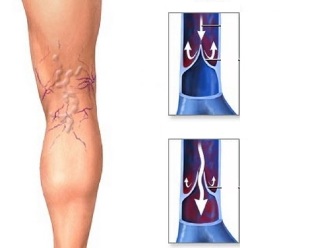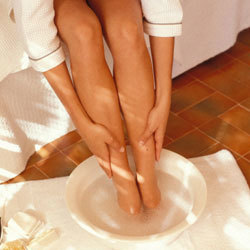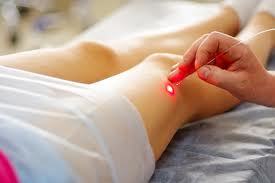
Varicose veins (varicose veins) is one of the most common and oldest diseases of the cardiovascular system, which opened since the time of ancient egypt. With the help of the egyptian papyri and of the excavations was found a mummy with signs of varicose veins. This disease has interested and famous ancient physicians hippocrates, galen, avicenna, and later Troyanova, trendelenburg. So far, this disease has not lost its importance in modern medicine. The definition of "varicose veins" comes from the Latin word "varix", which means "extension", so that the disease received the name of "Varicose veins". This disease is characterized by the extension and the increase of the length of the veins peripheral in the form of a serpentine tortuosity (deformations), as well as the violation of reflux of the blood from him, arise as a result of the failure of the device and the weakening of its walls. The disease most often affects veins of the lower limbs, as well as the basic loading of the blood flow (a lot), what represents in them, so that they prefer this section. Varicose veins is located approximately 17% and 25% of the population. At the early age of the disease is the same as that of the boys as the girls. In adulthood, the same age that women develop in 2 - 3 times more than men due to the hormonal restructuring of the women (menstruation, pregnancy, menopause).
Causes and risk factors in the development of varicose veins
The exact cause of the disease is not known, only know that, under the influence of some factors develops the weakening of the valves, the pressure increase and the loss of elasticity of the wall of the surface waters and of connection of the veins. Risk factors:
- Genetic predisposition: the transfer of varicose veins by inheritance occurs as a result of the mutation in the gene responsible for the structure of the vascular wall, as a result of a mutation of the children born with the congenital weakness of the connective or muscular tissue of the vessel wall, or the disadvantage of the valve (the lack of their number), and as a result it produces a weakness of the vessel wall and increased pressure in the veins.
- Hormonal changes (pregnancy, menopause): during pregnancy changes the hormonal composition of the body (increased levels of progesterone and reduced estrogen), affecting the education of the clotting factors of the blood (increase) decrease of tone of the vein wall (as a result of the destruction of collagen and elastin fibres in the wall of the vessel). all of this leads to the formation of blood clots, obstruction of the vessels and their deformations.
- Obesity : excess weight leads to the sedentary style of life, in which occurs the deceleration of the circulation of the blood, the more excess fat increases the intra-abdominal pressure, which violates the reflux of the blood in the veins and, in consequence, develops a stagnation in the veins and the possible development of the disease.
- Diabetes mellitus :a chronic high level of blood sugar over time damages the walls of the vessels, which is a favorable environment for the development of blood clots.
- Alcohol abuse : excessive alcohol consumption causes dehydration and thickening of the blood, as a result forming blood clots that obstruct vienna, and violate the reflux of the blood.
- Weight lifting (chargers),a long walk, long years of stagnant or work (salesmen, drivers): this is related to the decreased muscle tone, increased intra-abdominal pressure, and as a result of the slowdown and the difficulty in the flow of blood to the heart and the development of its stagnation in the lower extremities.
- Congenital disorders of blood coagulation: the innate hypercoagulation (excessive production of factors such folding of the blood) leads to the formation of blood clots, and to the violation of the promotion of blood through the vessels.
- Poor nutrition: the lack of some vitamins (vit.C, E, P, plant fibers play a role in the strengthening of the vessel wall and the improvement of the circulation of the blood).
- The use of the underwear of the close permanent of their use leads to the mechanical compression of the veins, which causes the difficulty of venous reflux of the lower extremities.
- Chronic constipation : frequent increase of the intra-abdominal pressure (time, effort) that leads to the difficulty for the reflux of the blood from the lower limbs.
- Frequent walk in high heels: the lack of movement of the muscles of the leg and the development of stagnation.
- The hottest time of the year:: frequent thirst, leading to dehydration occurs the condensation of the blood and blood clots.
- Cardiovascular comorbidity or disease of the kidneys: it breaks the reflux of the venous blood (insufficiency of the heart valves, birth defects).
- An overdose of medications that increase the clotting of the blood: the risk of thrombosis and occlusion of the vessels.
- Surgical interventions:the loss of a volume of blood, not of the comfortable position in the table of operations (compression, some of the vessels), they run the risk of the occurrence of blood clots.

Complications of varicose veins
- The formation of blood clots, as a result of the stagnation of the blood in the veins;
- detachment of a blood clot and occlusion of the vessel, which coincides with that of its diameter;
- thrombophlebitis (due to the formation of a blood clot in the lumen of the vein causes the inflammation of the wall);
- pulmonary embolism (a separate blood clot in the blood stream enters the pulmonary artery, which participates in the circulation of the blood by the small circle. If the diameter of a blood clot coincides with the diameter of the trunk of the artery, can occur sudden death. If a blood clot is of smaller diameter, which passes beyond a branch of the pulmonary artery, causing a heart attack or lung oedema).
- ulcers, trophic, or eczema of the feet as a result of eating disorders (rape exists in relation to the circulation of the blood leads to the lack of oxygen in the tissue, which is the most important of the nutrition of the tissues of the body);
- the swelling of the different parts of the body as a result of the stagnation of the veins (which are soft, elastic, cyanotic color, your education does not depend on the time of day, often form on the area of the affected area);
- dermatitis (inflammation of the skin in the affected area), at the expense of eating disorders of this parcel;
- the change of color of the skin in the affected area of the parcel;
- the seal of the fat deposits in the area of the zone affected by the account of the gland.
The diagnosis of varicose veins
- The flagellum (functional) of the sample (definition of the feasibility of the veins and of their state of valves): Troyanova - trendelenburg,pratt, Shania, Delbe-perthes, and others. One of the most common of the sample Troyanova - trendelenburg with help of which the patient, while in a horizontal position, lift the foot at 45 0, the doctor makes the rubbing of the feet upwards, which drain the superficial veins), then a tourniquet on the upper part of the thigh and asks the patient to rise, in the standard filling of the veins of the leg must occur more than 15 seconds;
- Duplex ultrasound scanning of the veins (ultrasound angioscanning) more informative method to assess the blood flow in the vessel and see the glass;
- Dopplerhophy - method by which only evaluates the blood flow in this vessel;
- Phlebography - the introduction of contrast medium intravenously and the study of the x-ray of the work;
- Phleboscintigraphy - intravenous radiopharmaceutical and special surveillance of the device.
The treatment of varicose veins
Non-surgical treatment

- Popular methods of treatment (as a complement to medical treatment: the use of compression (stockings); physical exercises (swimming, cycling, skiing, the legs above the head of approximately 20 0 in front of the bed, the group of gymnastics ("the bicycle" - lying on the back and gently breathing in, imagine that you turn the crank of the pedal of the bicycle; alternately bending and straightening s? of the foot at the ankle joint forward and backward) are applied to improve the blood flow, but only in non-complicated cases), contrast shower (under running water to keep the feet, gradually reducing the temperature of the water reaching cold); of france (not hot) decoction of the bark of the oak, horse chestnut, chamomile extract, st. john's wort; Swedish alcohol tincture of acacia flowers, leaves Kalanchoe, the cider vinegar; when thrombophlebitis treatment with leeches.
- Mode of day: in the morning, slow to get out of bed (for approximately 5 to 10 minutes), during sleep puts the roll under the heel to lift your legs for about 15-20 0 with respect to the bed, walking should be quiet, can't sit crossed legs crossed, gathering foot elastic band that go from the feet to the top of the thighs, the medical use of socks, nutrition, to avoid the tedious movements and of any substances or factors that contribute to the thickening of the blood, the elimination of cigarette smoking, prevention of constipation.
- Diet : the body needs products that contain vitamins strengthen the walls of blood vessels and improve blood flow: vitamin c (as found with citruses, tomatoes, rose hip oil etc), vitamin E (vegetables, liver, egg yolk, green onion), vitamin P (grapefruit, walnut, black currant), bioflavonoids (dark cherry, cherry acidic), copper (shellfish). Sufficient daily amount of liquid is not less than 1.5 litres. You will limit the consumption of alcoholic beverages, coffee, pickles, smoked.
The surgical treatment

Phlebectomy:the Indications of vein ablation: a wide varicose veins, subcutaneous vienna pathologically expand trophic of the violation of the skin that do not respond to conservative treatment, thrombophlebitis, acute, varicose veins, subcutaneous is accompanied by a violation of the general conditions (expressed as fatigue, swelling of the legs of the patient. Contraindications to the removal of the veins: disease of the coronary arteries, the severe infections of the processes, the age of the patient, the pregnancy in 2 and 3 quarters, inflammatory processes in the legs (erysipelas the inflammation, gangrenous, eczema). Advantages of the surgical treatment: the only form of treatment in the cases, the only radical method of correction of the valves of the deep veins. Disadvantages of surgical treatment: traumatic (cosmetic defect), requires anesthesia, is necessary to several days in the hospital under the supervision of a surgeon. Lazeroterapiya (endovascular microtermocoagulation) :Indications: the Combination of varicose veins with the following diseases: diseases of the cardiovascular system (coronary heart disease, high blood pressure), peripheral vascular disease (phlebitis, thrombophlebitis), respiratory (bronchial asthma, bronchitis, pleurisy), diseases of the digestive system (cholecystitis, ulcer of stomach and duodenum), diseases of the nervous system (craniocerebral trauma, neuroinfections), diseases of the genitourinary system (pyelonephritis, endometritis, salpingitis), with skin diseases (dermatitis, Neurodermatitis), peritonitis, boils. Contraindications: people who suffer from diseases such as cancer, diseases of the liver, the kidney and the heart in the phase of decompensation sclerosis cerebral in pregnancy. Advantages: allows you to get rid of the unpleasant vascular image, a process of rapid (15-20minutes), no hospitalization required, safe and pain free, it does not hurt the glass of the fabric and the tissues that surround it. Disadvantages: not always available method expensive, to remove more of the large vessels is possible thermal damage in the tissues, the possible formation of scars and de-pigmentation (lighten) skin in the field of exposure. Radiofrequency coagulation (ablation) of varicose veins: Indications: varicose disease, with the defeat of the large trunk and small saphenous vein, ulcers trophic, as a result of varicose veins. Contraindications: acute thrombophlebitis of the great saphenous vein, the impossibility of active walking, pregnancy, mental disorders. Advantages: without a cosmetic defect, painless, requires no hospitalization, does not violate the capacity of work. Disadvantages: the only disadvantage is the price of the treatments. Sclerotherapy: Indications: small varicose surgery, the enlargement of varicose veins, when used in a dopplerography, varicose veins in the early stages (if it is damaged only surface veins. Contraindications: pregnancy and lactation, allergy to sclerosus, deep vein thrombosis, supurativas inflammatory disease of the feet. Advantages: lower cost compared with the surgery, quick recovery period, it does not require stay in the hospital (you may go home immediately), the best cosmetic result. Disadvantages:possible impact in the deep veins sclerosus, reduces the efficiency due to the mixture of sclerosus with blood, is not effective in the cases.






































